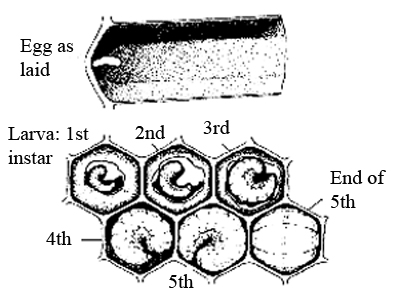There are three development stages in bees which collectively are known as brood. Bees begin their life in the tiny white egg stage. A queen will deposit one egg in each worker or drone cell. The eggs are about the diameter of a pin and stand on end in their cells. They are very difficult to see. The eggs that will develop into workers are fertilized, while the eggs that will yield drones are not. We cannot tell the difference between fertilized and unfertilized eggs but the bees can. If the queen makes a mistake, the egg is removed and destroyed by worker bees. The egg stage lasts three days.
When an egg hatches it becomes a larva. The bee larva (plural: larvae) is a legless and featureless white grub. It is specialized to eat and never leaves the individual wax cell. Larvae grow at a rapid rate in a five-step development called metamorphosis, increasing 1500 times the original size. The larvae are visited 10,000 or so times during their development by adult nurse bees for inspection, feeding and eventually capping of the cells. Worker bees bring food place it in the cell. They do not directly feed the larva.

The last stage, sometimes termed the prepupa, engorges on extra food before the cell is sealed with a wax capping. The pupal development stage for drones is 6.5 days, workers 6 days, and queens 5.5 days. If brood nest temperature drops, development takes longer. When fully grown and filling the cell the larva changes to a pupa (plural: pupae). The pupal stage, frequently termed capped stage, is one of change . the grub-like larva rapidly takes on the features of the adult. It does so still in the same cell that has now been capped with wax by the workers. In addition to containment in a capped cell, the last larval stage also spins a thin silk cocoon within each cell to enclose the pupa. The pupa does not eat or move.
All bee larvae (female and male) receive royal jelly after the egg hatches. Royal jelly is a protein-rich food made in the glands of worker bees and placed in cells just before the egg hatches. Initially the cell with a young larva is mass provisioned. A pool of royal jelly is kept replenished in the bottom of the cell and the C-shaped larvae simply lie in a pool of its food. After 2.5 to 3 days, however, the diet of the worker and drone larva changes to a mixture of pollen and nectar and food is not so generously supplied. This is called progressive-provisioning. The queen larva remains on a diet of royal jelly, continued in generous supply, her entire larval life.
Back to Basic Bee Biology for Beekeepers table of contents
Source:
The above text is taken from The Mid-Atlantic Apiculture Research & Extension Consortium, Basic Bee Biology for Beekeepers; Fact Sheet,MAAREC Publication 1.4 March 2004. You can download this factsheet and others at the MAAREC website
